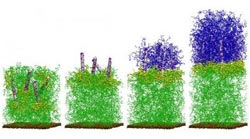Polymer gel, heal thyself: University of Pittsburgh engineering team proposes new composites that can regenerate when damaged

This is a self-generating composite image.<br><br>Credit: University of Pittsburgh<br>
That potential is now possible according to researchers at the University of Pittsburgh Swanson School of Engineering, who have developed computational models to design a new polymer gel that would enable complex materials to regenerate themselves.
The article, “Harnessing Interfacially-Active Nanorods to Regenerate Severed Polymer Gels” (DOI: 10.1021/nl403855k), was published November 19 in the American Chemical Society journal Nano Letters.
Principal investigator is Anna C. Balazs, PhD, the Swanson School's Distinguished Robert v. d. Luft Professor of chemical and petroleum engineering, and co-authors are Xin Yong, PhD, postdoctoral associate, who is the article's lead author; Olga Kuksenok, PhD, research associate professor; and Krzysztof Matyjaszewski, PhD, J.C. Warner University Professor of Natural Sciences, department of chemistry at Carnegie Mellon University.
“This is one of the holy grails of materials science,” noted Dr. Balazs. “While others have developed materials that can mend small defects, there is no published research regarding systems that can regenerate bulk sections of a severed material. This has a tremendous impact on sustainability because you could potentially extend the lifetime of a material by giving it the ability to regrow when damaged.”
The research team was inspired by biological processes in species such as amphibians, which can regenerate severed limbs. This type of tissue regeneration is guided by three critical instruction sets – initiation, propagation, and termination – which Dr. Balazs describes as a “beautiful dynamic cascade” of biological events.
“When we looked at the biological processes behind tissue regeneration in amphibians, we considered how we would replicate that dynamic cascade within a synthetic material,” Dr. Balazs said. “We needed to develop a system that first would sense the removal of material and initiate regrowth, then propagate that growth until the material reached the desired size and then, self-terminate the process.”
“Our biggest challenge was to address the transport issue within a synthetic material,” Dr. Balazs said. “Biological organisms have circulatory systems to achieve mass transport of materials like blood cells, nutrients and genetic material. Synthetic materials don't inherently possess such a system, so we needed something that acted like a sensor to initiate and control the process.”
The team developed a hybrid material of nanorods embedded in a polymer gel, which is surrounded by a solution containing monomers and cross-linkers (molecules that link one polymer chain to another) in order to replicate the dynamic cascade. When part of the gel is severed, the nanorods near the cut act as sensors and migrate to the new interface. The functionalized chains or “skirts” on one end of these nanorods keeps them localized at the interface and the sites (or “initiators”) along the rod's surface trigger a polymerization reaction with the monomer and cross-linkers in the outer solution. Drs. Yong and Kuksenok developed the computational models, and thereby established guidelines to control the process so that the new gel behaves and appears like the gel it replaced, and to terminate the reaction so that the material would not grow out of control.
Drs. Balazs, Kuksenok and Yong also credit Krzysztof Matyjaszewski, who contributed toward the understanding of the chemistry behind the polymerization process. “Our collaboration with Prof. Matyjaszewski was exceptionally valuable in allowing us to accurately account for all the complex chemical reactions involved in the regeneration processes” said Dr. Kuksenok.
“The most beautiful yet challenging part was designing the nanorods to serve multiple roles,” Dr. Yong said. “In effect, they provide the perfect vehicle to trigger a synthetic dynamic cascade.” The nanorods are approximately ten nanometers in thickness, about 10,000 times smaller than the diameter of a human hair.
In the future, the researchers plan to improve the process and strengthen the bonds between the old and newly formed gels, and for this they were inspired by another nature metaphor, the giant sequoia tree. “One sequoia tree will have a shallow root system, but when they grow in numbers, the root systems intertwine to provide support and contribute to their tremendous growth,” Dr. Balazs explains. Similarly, the skirts on the nanorods can provide additional strength to the regenerated material.
The next generation of research would further optimize the process to grow multiple layers, creating more complex materials with multiple functions.
Media Contact
More Information:
http://www.pitt.eduAll latest news from the category: Materials Sciences
Materials management deals with the research, development, manufacturing and processing of raw and industrial materials. Key aspects here are biological and medical issues, which play an increasingly important role in this field.
innovations-report offers in-depth articles related to the development and application of materials and the structure and properties of new materials.
Newest articles

Properties of new materials for microchips
… can now be measured well. Reseachers of Delft University of Technology demonstrated measuring performance properties of ultrathin silicon membranes. Making ever smaller and more powerful chips requires new ultrathin…

Floating solar’s potential
… to support sustainable development by addressing climate, water, and energy goals holistically. A new study published this week in Nature Energy raises the potential for floating solar photovoltaics (FPV)…

Skyrmions move at record speeds
… a step towards the computing of the future. An international research team led by scientists from the CNRS1 has discovered that the magnetic nanobubbles2 known as skyrmions can be…





















